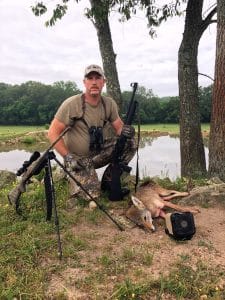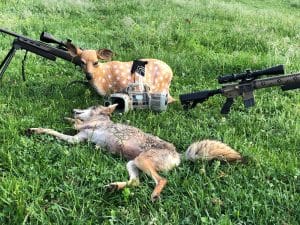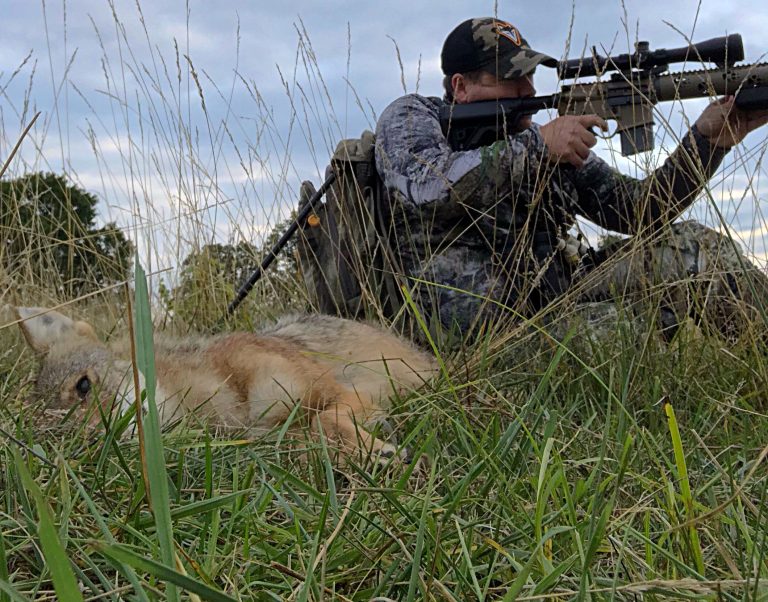“I’m finished cutting hay if you boys want to try calling in a coyote,” said a local farmer during a phone call. Tall summer grass in pastures and hayfields usually makes it challenging for hunters to spot a fast-approaching coyote. So when a farmer lets you know the hay is down, you don’t waste any time; it’s go time for coyote hunting.
On an early summer morning, a good friend and I headed to the fresh-cut farm to try calling in a coyote. I set up a Grim Speaker 2 call by Johnny Stewart Calls. This small electronic call was perfect for carrying a few hundred yards while walking in. After the call was in place, we moved back thirty yards and got ready to make the first call. I began with a short series of coyote howls to help introduce a coyote into the area. A couple of minutes later, I started playing a baby cottontail in distress sound. It wasn’t long before my friend whispered, “Coyote! coyote!” Standing at the edge of a low, wooded, shady area that separated two hay fields was a curious coyote, looking to see where the sound was coming from. Again, my friend whispered, “I am on him.” I quickly replied with, “Shoot him!” The coyote dropped a hundred yards from our setup. Another fawn was saved, and a hunt was well enjoyed.

There’s no denying the satisfaction of calling in a coyote and making a clean shot. But for serious whitetail hunters, the thrill goes beyond the hunt itself. It’s about tipping the balance in favor of healthier deer herds. When fawn recruitment suffers due to heavy coyote predation, it affects the entire hunting season. That’s why predator control isn’t just a side hobby for hunters; it’s a vital part of deer herd management. These advanced coyote hunting tips and predator hunting strategies are what I’ve leaned on to make a real difference with the land I hunt on, and they’ll help you do the same.
Why Predator Control Matters

Studies have shown that coyotes are responsible for 60–80% of fawn mortality in some regions. A survey in south-central South Carolina estimated fawn mortality at 77%, with coyotes confirmed or probable causes of 88% of those deaths. Another study in Georgia found that coyotes are the primary cause of fawn mortality in areas where both bobcats and coyotes coexist. This means that every fawn born has only a coin flip’s chance, or worse, of surviving, mainly due to predators like coyotes. I’ve seen the results firsthand; I’ve had trail cameras showing twin fawns in June and only one in September, as well as visual interactions of coyotes trying to lure a young fawn away from a doe on the edge of a road while passing by. That’s why implementing effective predator hunting strategies is so critical. You’re not just hunting for fun; you’re defending your deer herd. For landowners and serious deer managers, controlling coyote populations is as essential as establishing food plots and improving habitat.
Do You Know Coyotes?
The first step to success in any hunt is understanding your prey, and with coyotes, that means studying their seasonal patterns and behaviors. As an avid predator hunter, it is vital to know that during the breeding season, typically from January through March, coyotes become more vocal and responsive to howls. Come spring and summer, they raise and feed pups while constantly hunting, making it a prime time to use distress calls and significantly impact the coyote population, especially during the peak period when they are feeding on fawns. In fall and winter, they focus on survival, making food calls indispensable.
Coyotes are most active at dawn and dusk, but as pressure increases, they often shift their activity to later at night. I’ve had the most success adjusting my times based on good scouting data and temperature drops. Knowing when and how they move is the foundation of practical coyote hunting tips. Additionally, confirming the presence of coyotes in the area through game pictures, scouting tracks, den sites, howling, and locating them at night is key. These scouting techniques help determine if the coyote population is high and if fawns are in danger.
Gear for Night & Day
The right gear makes a significant difference. For rifles, I prefer a flat-shooting .22-250 or .223 Rem for most setups. Both offer the speed and accuracy needed for quick shots at unpredictable ranges. However, during the summer, the fur is not suitable for harvesting, meaning you don’t have to worry about pelt damage. Since pelts are not an issue, any of the best caliber for coyote hunting you are comfortable shooting successfully is more than adequate.
In my home state of Missouri, artificial lights are only allowed to be used during February and March. As a result, most of my summer hunting takes place during daylight hours. However, in other parts of the country, hunting at night is allowed. At night, thermal optics are game changers. I use light aids, such as a thermal scope paired with a thermal monocular for scanning. This combination has allowed me to spot coyotes hundreds of yards away before they ever approach the call. Additionally, I employ a white or red scan light, either handheld or mounted directly to my gun while hunting. It’s important to check local regulations before using lights or thermals.

As for calls, mouth calls still hold a special place in my arsenal, especially when I want to add realism to a stand. I often use a diaphragm call to create a soft, subtle howl or the whine of a coyote pup. Even though a mouth call is one of my favorites, a high-quality electronic call is my go-to for volume and variety. I’ve relied on the FOXPRO X-Wave or HellCat Pro for the last few seasons with great success. These types of calls are deadly when paired with a remote decoy, such as the FOXPRO Jack Daddy, or a stationary fawn decoy, like the Montana Decoy Fawnzy Predator Decoy. Summer coyotes often have pups and are territorial, as well as curious about responding to a call. When they see a decoy, it provides quick confirmation to keep moving toward the sound they have been hearing.
Predator hunting is one type of hunting where camouflage isn’t as necessary. While hunters can use camouflage, especially in open terrain, it’s more important to pay attention to sitting in dark shadows and avoiding being silhouetted. If hunting at night, focus on breaking up your outline with natural cover and wear black or dark earth-tone clothing to blend into the shadows. Don’t overlook this; smart coyotes have survived by spotting what’s out of place.
Advanced Calling and Luring
Calling in a coyote isn’t just about pushing buttons; it’s about reading the situation. I always start my set with a few interrogation howls to see if I can elicit a response. If nothing answers back, I’ll wait five minutes and use a sequence of distress cries: cottontail, bird distress, or even fawn bleats if I’m hunting during the summer months. Remember, during the summer, many wildlife species are raising their young, so use baby prey sounds to make your sounds more authentic.
Layering sounds is key. I’ll often follow up with coyote pup distress calls to simulate a fight or to trigger territorial instincts. Using decoys like spinning tails or realistic full-body fawn mounts can seal the deal.
Strategic Setups
You can have all the gear and calls in the world, but if your setup is wrong, you’re beaten before you begin. Coyotes always try to get downwind, and not just the raised by coyotes shirts. Always. So, I set up with the wind blowing crosswind or in my face and expect them to circle. I like elevated spots, hilltops, hay bale stacks, or even ladder stands so that I can see those broad approaches.

Dawn and dusk still produce coyotes because these are the cooler parts of the day during a hot summer. However, don’t overlook midday on overcast days or after a cold front. These conditions can stir daytime movement. Recently cut hay fields, as mentioned earlier, are also a good reason to hunt midday. Rotate spots regularly and don’t overhunt the same stand. Intelligent predators adapt quickly to pressure.
Safety and Ethics
Night hunting requires a higher level of discipline. Understand your backdrop before pulling the trigger; thermal scopes don’t reveal trees or rocks that can stop or ricochet a bullet. Use safety lights or IR beacons when hunting in teams. Communication is crucial, especially when using suppressed firearms or thermal devices.
Ethically, remember your goal: predator management, not extermination. Coyotes are an integral part of the ecosystem, and your role is to keep their populations in check, not to eliminate them. Take good shots, recover your animals, and be respectful of both private and public lands.
Predator hunting is one of the most thrilling and effective ways to improve deer herd health. These coyote hunting tips and predator hunting strategies are the result of years of trial and error, as well as countless sessions conducted during both the cold winter and hot summer months. If you’re serious about managing your whitetail population, you won’t care about the weather; you’ll pick up the call, dial in your gear, and go after the predators that are stealing your season before it even starts.
Per our affiliate disclosure, we may earn revenue from the products available on this page. To learn more about how we test gear, click here.




